#Indian Diplomacy
Text
China Uses Veto Power In Destroying Modi’s Dream
“Unaware of international affairs, Prime Minister Narendra Modi could not make out that diplomacy does not run on the basis of religion”
Dr Rahul Kumar*
For the last ten years, blind followers in India and abroad have been claiming that India’s global image under Modi’s leadership is heightened. It is further claimed that the world leaders are giving more importance to India than the previous…
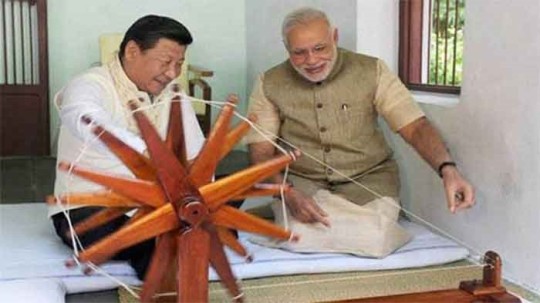
View On WordPress
#Diplomacy#Dr Jai Shanker#Galwan Valley#Indian-Chinese troops clash#Line of Actual Control#Modi&039;s failure on diplomatic front#Narendra Modi#UN Security Council#UNSC#Xi Jinping
0 notes
Text
Historic Moment: 'Bharat-UAE Dosti Zindabad' Echoes as PM Modi Wows Indian Diaspora at 'Ahlan Modi' Spectacle in Abu Dhabi
Historic Moment: ‘Bharat-UAE Dosti Zindabad’ Echoes as PM Modi Wows Indian Diaspora at ‘Ahlan Modi’ Spectacle in Abu Dhabi!”
In a momentous occasion that resonated with patriotic fervor, Prime Minister Narendra Modi delivered an electrifying speech at the ‘Ahlan Modi’ event in Abu Dhabi, cementing the bonds of friendship between India and the UAE. The event, attended by thousands of enthusiastic…
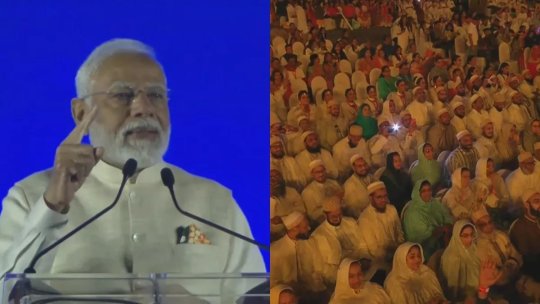
View On WordPress
#Abu Dhabi Event#Ahlan Modi#Bharat-UAE Friendship#Cultural Exchange#Diplomacy#Friendship#Indian Diaspora#PM Modi
0 notes
Text
As The Israel-Hamas Situation Escalates, Indian Diplomacy Feels The Strain
Harsh V. Pant
As tensions continue to escalate in the Middle East, diplomacy too has picked up pace with US President Joe Biden deciding to visit Israel to assess Israeli plans. After the attack on a Gaza hospital last night left 500 dead and amid reports of an impending Israeli ground offensive, there are growing concerns about the humanitarian toll and its long term costs. There is the issue of…
View On WordPress
0 notes
Text
youtube
Welcome to the world of inspiration, creativity, and thoughtful exploration! 🌟 Join us on this journey as we share captivating stories, art, and ideas that spark your imagination and enrich your perspective. From stunning visuals to thought-provoking narratives, we're here to ignite your curiosity and celebrate the beauty of expression. Follow us for a daily dose of inspiration and be part of our vibrant community. Let's embark on this creative voyage together! 🚀 #Inspiration #Creativity #ExploreMore
#india#india news#india foreign policy#indian#s jaishankar#diplomacy#biden administration#mahatma gandhi#international relations#indian american#gandhijayanti#diplomatic ties#indian community#Youtube
0 notes
Text
Send Indian Peacekeepers! Europe Keeps Killing Itself | General Günther Greindl
youtube
Europe needs some serious help from India, Africa, and South America to stop its constant warfare. Listen to the ideas of Austrian General Günther Greindl of how an Indian peacekeeping force could be part of the solution to the war in Ukraine.
#Indian Peacekeeping#New Delhi#European Insecurity#EU foreign policy#Cyprus Peace Process#Sky Shield#European Diplomacy#Nonaligned Movement#New Nonalignment#NATO Warmongering#Youtube
1 note
·
View note
Text
A woman of Indian origin in the US presidential race

Nikki Haley, a woman of Indian origin, will stand in the US presidential race. She has good experience in politics as well as diplomacy. Haley previously served as the governor of South Carolina. He served as the US Ambassador to the United Nations from 2017 to 2018 under former President Donald Trump. In this order, she spoke about the competition in the upcoming presidential election.
#Today news#Nikki Haley#Women of Indian Origin#US Presidential Race#Politics#Diplomacy#Governer South Carolina#President Donald Trump#Presidential Election#Trending#latest news
0 notes
Text
India provocations will not go unanswered,China is ready for a clash of titans.
The post is machine translated
The translation is at the bottom
The collective is on telegram
⚠️ L'ESERCITO POPOLARE DI LIBERAZIONE HA DISPIEGATO CACCIA MULTIRUOLO E DRONI DA RICOGNIZIONE PRESSO BASI AEREE VICINO AL CONFINE CON L'INDIA ⚠️
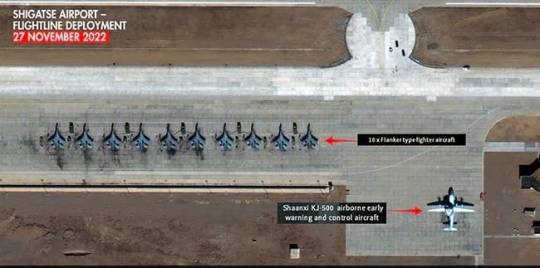



🇨🇳|🇮🇳 Dopo lo "Scontro del 9 Dicembre" a Dáwàng Zhèn tra le Forze Armate dell'India e l'Esercito Popolare di Liberazione, è stato notato - tramite immagini satellitari - il dispiegamento di UAV ed Aerei dell'EPL negli Aeroporti e nelle Basi Aeree della Regina Autonoma del Tibet
✈️ Dall'11 dicembre, presso la Base Aerea di Shigatse, si possono notare:
➖ 10 Caccia Multiruolo J-16 - [FOTO 1]
➖ Almeno 1 Aereo da Sorveglianza e Controllo Aviotrasportato KJ-500 - [FOTO 1]
✈️ Alla Base Aerea di Bangda - che dista 150km dall'Arunachal Pradesh - si possono notare:
➖ 1 UAV da Ricognizione WZ-7 - [FOTO 2]
➖ 1 UAV da Ricognizione e da Combattimento CH-4B - [FOTO 3]
➖ 2 Caccia Multiruolo J-16 [FOTO 4]
🐲 La messa in servizio del WZ-7 e del CH-4B - nonché il loro uso operativo - indicano che è stato creato con successo un ambiente perfettamente funzionante per supportare missioni speciali nella Regione dell'Aksai Chin 🔥
💭 Tali immagini dalla Base Aerea di Bangda sono apparse il giorno prima delle esercitazioni dell'Aeronautica Indiana al confine con la Cina, ciò significa che il Partito Comunista Cinese - tramite le sue Agenzie di Intelligence - era a conoscenza dei piani dell'India, e si è dunque - intelligentemente - preparato in anticipo per seguire le tattiche dell'Aeronautica Indiana, osservando e studiando i movimenti dell'India per effettuare operazioni di contrasto nell'ambito di un conflitto ⚔️
🇨🇳 Ciò significa che l'infrastruttura militare creata negli ultimi mesi - aeroporti, eliporti, sistemi di difesa area, linee di comunicazione - ha permesso e permetterà all'Esercito Popolare di Liberazione di dispiegare rapidamente forze e mezzi qualora la situazione con l'India si aggravasse.
🌸 Iscriviti 👉 @collettivoshaoshan
⚠️ THE PEOPLE'S LIBERATION ARMY DEPLOYED MULTI-ROLE FIGHTERS AND SCAN DRONES AT AIR BASES NEAR THE INDIA BORDER ⚠️
🇨🇳|🇮🇳 After the "December 9th Clash" in Dáwàng Zhèn between the Armed Forces of India and the People's Liberation Army, it was noted - via satellite images - the deployment of PLA UAVs and Aircraft at the Airports and in the Tibet Autonomous Queen Air Bases
✈️ Since December 11, at Shigatse Air Base, you can see:
➖ 10 J-16 Multirole Fighters - [PHOTO 1]
➖ At least 1 Airborne Surveillance and Control Aircraft KJ-500 - [PHOTO 1]
✈️ At the Bangda Air Base - which is 150km away from Arunachal Pradesh - you can see:
➖ 1 WZ-7 Reconnaissance UAV - [PHOTO 2]
➖ 1 CH-4B Reconnaissance and Combat UAV - [PHOTO 3]
➖ 2 J-16 Multirole Fighter [PHOTO 4]
🐲 The commissioning of the WZ-7 and CH-4B - as well as their operational use - indicate that a fully functional environment has been successfully created to support special missions in the Aksai Chin Region 🔥
💭 Such images from Bangda Air Base appeared the day before the Indian Air Force exercises on the border with China, this means that the Communist Party of China - through its Intelligence Agencies - was aware of India's plans, and he therefore - intelligently - prepared in advance to follow the tactics of the Indian Air Force, observing and studying India's movements to carry out contrast operations in the context of a conflict ⚔️
🇨🇳 This means that the military infrastructure created in recent months - airports, heliports, air defense systems, communication lines - has allowed and will allow the People's Liberation Army to rapidly deploy forces and means should the situation with India got worse.
🌸 Subscribe 👉 @collettivoshaoshan
#socialism#china#italian#translated#china news#communism#collettivoshaoshan#western imperialism#india army#indian border#india news#politics#diplomacy#war#border conflict#china army#people liberation army#pla#marxist#marxist leninist#marxism leninism#marxism
0 notes
Text
India-Taliban Relations: बदला-बदला सा तालिबान! आतंकी संगठनों के बारे में भारत को दिया ये भरोसा, जानिए पूरी डिप्लोमेसी
India-Taliban Relations: बदला-बदला सा तालिबान! आतंकी संगठनों के बारे में भारत को दिया ये भरोसा, जानिए पूरी डिप्लोमेसी
Image Source : FILE PHOTO
India-Taliban Relations
Highlights
अल-कायदा की धमकी के बाद तालिबान ने दिया भरोसा
खस्ता हालत में भारत ने खाद्यान्न और अन्य आर्थिक मदद देकर विश्वास में लिया
कोरोना के दौरान 75,000 टन गेहूं भारत ने अफगानिस्तान भिजवाया था
India-Taliban Relations:अफगानिस्तान में जब से तालिबान शासन आया है, ये तालिबान बदला बदला सा नजर आ रहा है। हालांकि उनकी कट्टरता तो जगजाहिर है, लेकिन भारत…

View On WordPress
#A Taliban Revenge This trust given to India about terrorist organizations#india taliban#India-Taliban Relations#indian delegation to kabul#kabul#know complete diplomacy#National Hindi News#बदला-बदला सा तालिबान आतंकी संगठनों के बारे में भारत को दिया ये भरोसा
0 notes
Text
With a history of short-term governments in Nepal’s 15 years of democratic progression, the current reconfiguration is no surprise, and it will be no surprise if the Maoists get back again with the Nepali Congress in months and years to come.
Power sharing, political discontent, ideological differences, underperformance, and pressure to restore Nepal to a Hindu state – a long list of reasons reportedly forced the Maoists to sever ties with the Nepali Congress. While the Nepali Congress expected the Maoist leader and current prime minister, Pushpa Kamal Dahal (also known by his nom de guerre, Prachanda) to leave the alliance, it did not expect an overnight turnaround. [...]
Dahal reportedly conveyed to the Nepali Congress chair, former Prime Minister Sher Bahadur Deuba, that external pressure forced him to join hands with CPN-UML and form a new government.
If this assertion is true, China emerges as a plausible factor, given its historical inclination toward forging alliances with leftist parties in Nepal. This notion gains credence in light of China’s past efforts, such as its unsuccessful attempt in 2020 to mediate the conflict between Oli and Dahal.
On the other hand, India has enjoyed a comfortable working relationship with the Nepali Congress and the Maoists. Although Maoists were a challenging party for New Delhi to get along with when Dahal first gained the prime minister’s seat in 2008, the two have come a long way in working together. However, the CPN-UML has advocated closer ties with the northern neighbor China; Beijing suits both their ideological requirements and their ultra-nationalistic outlook – which is primarily anti-India. [...]
India faces challenges in aligning with the Left Alliance for two key reasons. First, the energy trade between Nepal and India has grown crucial over the past couple of years. However, India strictly purchases power generated through its own investments in Nepal, refusing any power produced with Chinese involvement. With the CPN-UML now in government, Nepal may seek alterations in this arrangement despite the benefits of power trade in reducing its trade deficit with India.
Second, India stands to lose the smooth cooperation it enjoyed with the recently dissolved Maoist-Congress coalition. During the dissolved government, the Nepali Congress held the Foreign Ministry, fostering a favorable equation for India. Just last month, Foreign Minister N.P. Saud visited India for the 9th Raisina Dialogue, engaging with top Indian officials, including his counterpart, S. Jaishankar.
As concerns arise for India regarding the Left Alliance, there is also potential for shifts in the partnership between Nepal and the United States, a significant development ally. Particularly, there may be a slowdown in the implementation of the Millennium Challenge Corporation (MCC) projects. Despite facing domestic and Chinese opposition, the Nepali Parliament finally approved a $500 million MCC grant from the United States in 2022, following a five-year delay.
China perceives the MCC as a component of the U.S.-led Indo-Pacific strategy, countering its BRI. Hence Beijing aims to increase Chinese loans and subsidies to Nepal to enhance its influence.
To conclude, the re-emergence of Nepal’s Left Alliance signals a shift in power dynamics, impacting domestic politics and regional geopolitics. With China’s influence growing, Nepal’s foreign policy may tilt further toward Beijing, challenging India’s interests. This shift poses challenges for India, particularly in trade and diplomatic relations, while also affecting Nepal’s partnerships with other key players like the United States.
[[The Author,] Dr. Rishi Gupta is the assistant director of the Asia Society Policy Institute, Delhi]
6 Mar 24
229 notes
·
View notes
Text

Batboys as Desi Films

𝐃𝐢𝐜𝐤 𝐆𝐫𝐚𝐲𝐬𝐨𝐧
Dilwale Dulhania Le Jayenge (1995)

Raj and Simran meet during a trip across Europe and end up getting stranded in the middle of nowhere after they miss their train. Despite their initial clashing, they fall in love. However, Simran’s traditional father has arranged her marriage elsewhere. Raj must win over Simran’s family to marry her, leading to a series of heartfelt moments, comedic misunderstandings, and ultimately, a dramatic climax where love conquers all as the couple fights for their happiness against societal norms.
Dick is so raj coded with his quips and charisma. Their chaotic banter and chemistry is off the charts. Any Indian who hasn’t watched this gets their desi card revoked immediately, I don’t make the rules. This movies fits Dick’s dramatic flair perfectly.

𝐉𝐚𝐬𝐨𝐧 𝐓𝐨𝐝𝐝
Goliyon ki Raasleela Ram-Leela (2013)
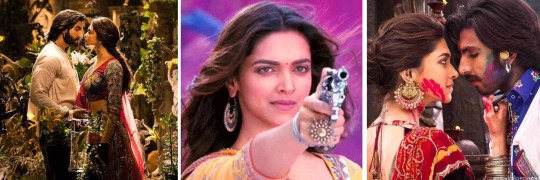
The modern adaptation of William Shakespeare’s “Romeo and Juliet,” set in rural Gujarat, India. It follows the love story of Ram, from the Rajadi clan and Leela, from the Sanera clan, who belong to rival gangster clans engaged in a long-standing feud. Despite the enmity between their families, Ram and Leela fall deeply in love, leading to a tragic and tumultuous journey filled with passion, violence, and sacrifice.
It fits Jason’s love for guns and classics. An absolute visual treat with cinematography and all the songs are absolute bangers.

𝐓𝐢𝐦 𝐃𝐫𝐚𝐤𝐞
Jab We Met (2007)

Aditya, a heartbroken business tycoon, someone who was dwelling in the lowest ebb of his life and was almost on the brink of giving it all up, aimlessly boards a train to escape his depressing life. On his journey he meets Geet, a talkative and vivacious young woman. Geet is on her way to meet her boyfriend, but her plans go awry, and she ends up stranded. Aditya, feeling sorry for her, decides to help her get to her destination safely. Along the way, they encounter various adventures and challenges that bring them closer together. Despite their contrasting personalities, they develop a deep connection. However, when they part ways, Aditya realizes his love for Geet and sets out to find her. In the end, they reunite, realizing they are meant to be together.
Grumpy x sunshine. The OG green flag. Epitome of ‘if he wanted to,he would’. Makes my chatterbox heart happy because of how much I relate to the FL. Favourite comfort movie of all time. ML kinda looks like Cillian Murphy’s scarecrow. “I like you a lot but that is my problem, you don’t need to worry about it.” Their fights and his little sassy comebacks and rants were so cute and fun to watch.

𝐃𝐚𝐦𝐢𝐚𝐧 𝐖𝐚𝐲𝐧𝐞
Jodhaa Akbar (2003)

The Mughal emperor Akbar, seeking to forge political alliances, marries Jodhaa, a Rajput princess. Initially a marriage of convenience, their relationship evolves as they learn to respect and love each other. Jodhaa struggles to adapt to Mughal customs, especially with their cultural and religious differences but her courage and integrity win Akbar's admiration. Despite conspiracies and opposition, including from Akbar's own court, their love prevails. The film explores the transformation of a young ruler, initially groomed for ruthlessness by his mentor Bairam Khan, into a wise and compassionate emperor who values mercy, diplomacy, religious harmony and cultural acceptance. Akbar's realization of the importance of religious tolerance, showcased through his abolition of discriminatory policies and his respect for all faiths.
The arranged marriage tag and the ‘raised as a weapon but softens and shows more compassion out of respect and love for his empress’ tag fits demonhead!Damian so much. The way he said mashallah after he pulled off her veil in the middle of a sword fight >>>>. I love how it captures the essence of India’s rich heritage and diversity. “Why seek paradise ? It is before me now.”

𝐁𝐫𝐮𝐜𝐞 𝐖𝐚𝐲𝐧𝐞
Khoobsurat (2014)
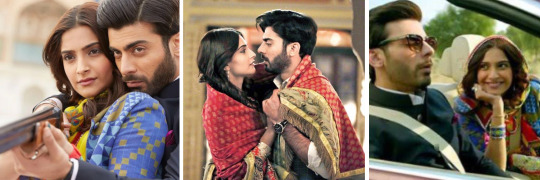
Milli, a free-spirited and eccentric young woman becomes the physiotherapist for a royal family. She brings her lively yet clumsy personality into the conservative royal household, shaking up their structured lives. It clashes with the formal atmosphere of the palace, especially with the stern matriarch, Nirmala Devi. Despite initial resistance, Milli's unconventional methods bring joy and laughter into the lives of the family members, including the brooding prince, Vikram. As Milli navigates the challenges of fitting into the royal household, she also finds herself falling in love with Vikram, leading to a series of comedic and heartwarming moments.
Very cliched (well it is a Disney film) and the second hand embarrassment is unreal but sometimes after a long day all you need is a feel-good cheesy rom-com. Oh to sit next to Fawad Khan in a red convertible while gazing lovingly at him. I like how she emphasises on improving the patient’s mental health to help him heal. Incase you haven’t noticed already, cold brooding™️ x silly goose is my favourite character dynamic.

𝐀/𝐍 - I’ll be honest with y’all, this was to satiate my desire of writing x desi! reader cuz I don’t have enough motivation or time to do it T^T

#batman#batfam#dick grayson#nightwing#dick grayson x reader#jason todd#red hood#red hood x reader#tim drake#red robin#tim drake x reader#damian al ghul#damian wayne#robin#damian wayne x reader#batboys#bruce wayne#batman x reader#bollywood#movies#bruce wayne x reader#ddlj#dilwale dulhania le jayenge#jab we met#khoobsurat#jodhaa akbar#ram leela
212 notes
·
View notes
Text
The East India Company ships
The East and West India Company ships were not ship types in the usual sense. They were generic terms for a series of merchant ship types that travelled between Europe and the overseas colonies in the East and West. Common features of these ships were three masts, several cannons and a high bulwark to make it more difficult for attackers to board them. Their valuable cargo made the ships attractive targets, so they often travelled in convoys, accompanied by medium-armed merchant ships or frigates for protection. But let's go into more detail.

The East Indiaman 'Earl of Abergavenny', off Southsea, by Thomas Luny 1801
The ships of the East India Company were the ships of the English East India Company, a public limited company (shipowners at the early time of the East India Company contributed their ships to the company and received a certain share in the company in return. They received a proportionate share of the company's overall profits and received a dividend even if their own ship was lost, since the 18th century the company build their own ones as well.) which traded with Asia from 1600 to 1834. The company had a monopoly on trade with the East Indies, China and other regions, and its ships carried goods such as spices, tea, silk, cotton, porcelain and opium. The company also played an important role in the colonisation and administration of India and other territories.

East India Company ships at Deptford, by English School, c. 1660
The ships of the East India Company were known as East Indiamen or as Indiamen and were among the largest and most modern of their time. They were designed to withstand long voyages, carry heavy cargoes and defend themselves against pirates and enemy ships. They were also equipped with cannons and muskets and had a crew of sailors, soldiers, officers and passengers. Because of the need to carry heavy cannons, the hull of the East Indiamen - like most warships of the time - was much wider at the waterline than on the upper deck, so the guns on the upper deck were closer to the centreline to increase stability. This is known as a tumblehome. The ships usually had two complete decks for accommodation within the hull and a raised aft deck. The aft deck and the deck below were lit by galleries with square windows at the stern. To support the weight of the galleries, the hull lines were full towards the stern. As mentioned above, the ships were armed and painted to look like a warship and an attacker could not be sure if the embrasures were real or just painted, and some Indiamen carried a substantial armament.
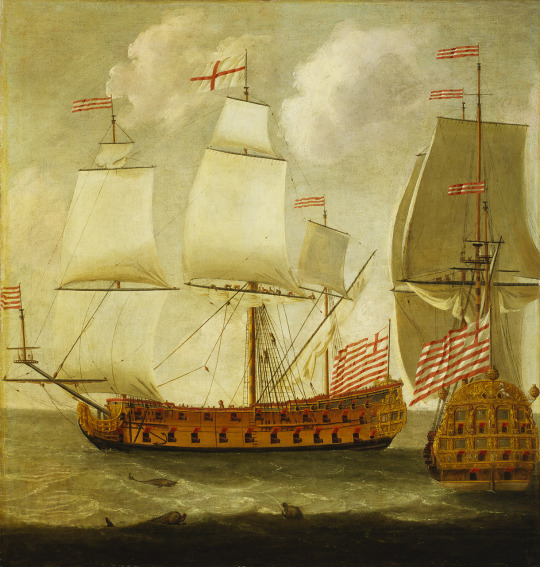
Two views of an East Indiaman of the time of King William III, by Issac Sailmaker, 1685
The Royal Navy acquired several East Indiamen during the Napoleonic Wars and made them fourth rate ships (e.g. HMS Weymouth and HMS Madras), perpetuating the confusion of military ships with merchant vessels as prizes. In some cases, the East Indiamen successfully fended off attacks by the French. One of the most famous incidents occurred in 1804 when a fleet of East India ships and other merchant vessels under Commodore Nathaniel Dance successfully fought off a squadron commanded by Admiral Linois at the Battle of Pulo Aura in the Indian Ocean. And during this time, some of the ships were even travelling under the protection of a Letter of Marque, which allowed them to make their own prizes.

The East Indiaman 'Prince of Wales' disembarking troops off Gravesend, 1845, by John Lynn, 1845 or later - She was built by Green's of Blackwall in 1842 to a design known as that of the "Blackwall Frigates" - Indiamen with the single-decked appearance of frigates.
The ships of the India Companies were not only involved in trade, but also in exploration, diplomacy, warfare and scientific research. They visited many harbours and islands, built factories and forts, fought in battles and wars, negotiated treaties and alliances and collected samples and data. With the advent of the smaller and faster Blackwall Frigates in 1834 came the end of the great Indiamen as these small frigates sailed much faster.
#naval history#east and west india company#ships#1600-1834#blackwall frigate#age of sail#merchant vessels
94 notes
·
View notes
Text
Deciphering Diplomacy: Prospects for the Indian Ocean’s Future - IMPRI Impact and Policy Research Institute
Anil Trigunayat
Recently, I happened to attend the 6th Indian Ocean conference ,2023 in Dhaka which was organized by the India Foundation in collaboration with Ministry of External Affairs of India and Ministry of Foreign Affairs of Bangladesh among others.
Earlier editions were hosted in Singapore, Bangkok, Abu Dhabi among others. The theme of the conference was Peace, Prosperity and Partnership…

View On WordPress
0 notes
Text

[The Pilgrims are assholes]
The First Thanksgiving is often portrayed as a friendly harvest festival where Pilgrims and generic, nameless "Indians" came together to eat and give thanks. In reality, the assembly of the Wampanoag Peoples and the English settlers in 1621 had much more to do with political alliances, diplomacy, and a pursuit of peace.
“The Wampanoag Peoples had a long political history dealing with other Native Nations before the English arrived. The Wampanoag shared their land, food, and knowledge of the environment with the English. Without help from the Wampanoag, the English would not have had the successful harvest that led to the First Thanksgiving. However, cooperation was short lived, as the English continued to attack and encroach upon Wampanoag lands in spite of their agreements.”
408 notes
·
View notes
Text
Madras [...] [was] the English East India Company (EIC)’s most important settlement on India’s Coromandel Coast [...]. [T]he town’s survival as an EIC colony often depended on the deployment of medical and natural historical knowledge in regional diplomacy during a critical period of its existence. [...]
---
Established in 1639, the English East India Company’s settlement at Madras (also known as Madraspatam or Chinapatam, now Chennai) had quickly become the focal point of EIC operations on the Coromandel Coast. By 1695, Samuel Baron described it as ‘the most considerable to the English nation of all their settlements in India whether ... in reference to the trade to and from Europe, or the Commerce from one part of India to the other’. The later attempts to establish trades to China and Japan, to resettle the Indonesian archipelago, and to gain a foothold in Bengal, were all directed from Fort St George. [...]
Browne [an English surgeon] used his patrons in the Mughal establishment and the Company hierarchy to build up a lucrative business supplying drugs to the camps of the Mughal generals. Browne’s contacts in the Mughal army were also useful for the Company [...].[D]uring the late seventeenth and early eighteenth centuries, Madras was in a difficult position. [...] Again, Company officials turned to the network of surgeons with access to the Mughal hierarchy [...]. In 1707, the year of the Emperor Aurangzeb’s death and a time of political unrest in the Mughal Empire, Bulkley was sent to Arcot on a mission that combined medical and diplomatic aims. While there, he also collected several volumes of plants and information about their medicinal virtues. [...] The network of contacts that could be built up between physicians, who had the advantage of close personal access to those at the centre of power, was an important way to exchange information and gifts. [...] Knowledge of plants and the means of employing them was thus crucial to establishing the East India Company’s position in India [...].
---
The Company’s gardens [...] also revealed, in their beds and borders, the networks that Madras was embedded within, as ships brought seeds and plants from other Company settlements, the territories of the rival European powers, and places of regional trade [...]. The surgeons used their space in the Company gardens to experiment with local plants and to introduce crops from around the world. [...] Both Browne and Bulkley also raised plants they received from their networks of correspondents overseas: Browne describes growing China root, a popular medicinal substance normally identified with Smilax China, rhubarb, cinnamon trees from Ceylon (Sri Lanka), and wild agallo, benjamin and camphor from Manilla. [...]
[T]he scramble for the manuscripts or [plant] collections [...] [demonstrates] that the acquisition of natural knowledge was a crucial part of the competition between European trading companies to acquire and exploit the wealth of the Indies. Each of the two surgeons [Browne and Bulkley] [...] also sent a huge amount of plant materials to various correspondents in Europe [...]. Among the contacts that the surgeons maintained in England were several London apothecaries including his brother-in-law, who ran a shop in Bread Street, and Mr Porter, a drug-gist in Cornhill Street. The circle of botanists who received collections from the East Indies formed a close, though not always friendly, group of experimenters and gardeners who constituted the overlapping membership of the East India Company, the Royal Society, and the Society of Apothecaries.
The web of contacts that the two surgeons maintain within the colonial world of the Indian Ocean were invaluable because they provided them with the materials necessary to make Madras a ‘centre of calculation’ by supplying them with materials on which comparisons and connections to their own collections could be drawn. [...] Bulkley wrote at a time of transition in both England and India. [...] However, it is clear at least that by the time Bulkley died in 1713, being buried at the end of his garden, the United Company was more securely established at Madras, as expressed in its now immaculate gardens.
---
The networks of doctors had been crucial diplomatic actors in a critical period during which many believed that Madras was fated to be eclipsed altogether. [...] It was the new relationship with the rulers of Arcot established by these doctors that eventually enabled the Company to consolidate its base at Calcutta.
The surgeons’ collections reflect the hybrid environment of early modern Madras and the networks – maritime, military and diplomatic – that the doctors were embedded in [...]. Many details are missing from this reconstruction of the practice of medicine and botany in the early colonial city. Unlike the contributors to the Hortus Malabaricus, we never learn so much as the names of the Tamil and Telugu-speaking doctors who were so crucial in collecting and revealing the medicinal uses of the specimens the surgeons sent to London. Nevertheless, the role of these collaborators was clearly crucial. [...]
The collections of these two surgeons, who were key players in the transformation of politics and botany in the region, straddling local and international concerns, in many ways provide the perfect portal through which to view Madras as it was transformed from a trading post subservient to the interests of regional powers to a major player in British colonial expansion.
---
All text above by: Anna Winterbottom. “Medicine and Botany in the Making of Madras, 1680-1720.” In: The East India Company and the Natural World, edited by Vinita Damodaran, Anna Winterbottom, and Alan Lester. 2014. [Bold emphasis and some paragraph breaks/contractions added by me.]
56 notes
·
View notes
Text
On Dec 10th, we venerate Elevated Ancestor & Saint Maȟpíya Lúta aka Chief Red Cloud on the 113th anniversary of his passing 🕊 [for our Hoodoos of First Nations descent]

Red Cloud, Chief of the Oglala Sioux, was a political leader, a negotiator of peace, & fierce warrior who fought tirelessly to save his people from colonizer expansion into the midwest.
Maȟpíya Lúta was born near the forks of the Platte River, in what was at the time known as the Nebraska Territory; to his Ogala Lakota mother & Brulé Lakota leader father.
He showed great courage, strength, & leadership in battles against the Oglala's traditional competitors once he came of age; the Pawnees, Crows, Shoshones, & Utes. This ultimately earned him Chiefdom. He also successfully killed the usurper rival to his uncle's political leadership. This divided the Oglala for years to come.
Once European invaders discovered gold in Montana in the 1860s, they began dessimating habitats, sacred lands, & territories to build a road from Fort Laramie in present-day Wyoming to the gold fields. They constructed a series of forts to protect the road from interference, which became known as the Bozeman Trail. In 1865, Chief Red Cloud led the Ogala & their Cheyenne allies into a 2-year war against the colonizers along the Bozeman Trail. They were successful. The soldiers, miners, & others were forced to abandon their operation.
Being the peaceful negotiator that he was, at the end of the war, Chief Red Cloud signed the Second Treaty of Fort Laramie, which bound the U.S. to the promise that it would abandon the Bozeman Trail & return - what is now the western half of South Dakota, along with large parts of Wyoming, & Montana - to Lakota Sioux possession. In return, Red Cloud agreed to end his assault & relocate to a reservation in Nebraska known as the Red Cloud Agency.
In his older age, the great warrior became a diplomat of peace. In 1870s, Chief Red Cloud, along with several other First Nations leaders, traveled to D.C. to meet with U.S. President Grant. He later met with Grant again in 1875, when Grant has the caucasity to offer $25K to the Lakota if they would give up their rights to hunt along the Platte River in the Dakota Territory. Red Cloud, and other leaders, vehemently refused.
While Red Cloud pursued the path of peaceful negotiation & passive tactics, many other Indian leaders (including his own son) wanted to fight for their territory & ways of life. Red Cloud & President Grant sought to avoid war, but it was inevitable. After Sitting Bull's crushing defeat of a U.S. 7th Calvary in June of 1876, Whites began perpetuating aggressively negative campaigns & propaganda against First Nations in the West. Even still, Red Cloud resisted the call to war. He pursued diplomacy. In 1878, he successfully lobbied for the removal of the Indian agent at Pine Ridge Agency due to poor treatment. He returned to D.C. several more times to lobby for his people & defend the rights of all First Nations. This led him to become the most photographed Native of the 19th Century.
Red Cloud continued his work to preserve native lands & to maintain the authority of traditional First Nations leader until he was removed from political power; this may have been influenced by his shifting views in favor colonialism via Christianity & adopted the first name, "John". He later died on the Pine Ridge Agency with his wife; blind & ailing. There he rests in the cemetery so named after him.
"The Whites are the same everywhere. I see them every day. They made us many promises, more than I can remember, but they never kept but one; they promised to take our land, and they took it. " - Chief Red Cloud.
We pour libations & give him💐 today as we celebrate him for his spirit of resistance & immense peace. May we look to him for wise counsel, peaceful resolutions, & as a lesson in the influential power of colonialism.
Offering suggestions: River water, peace pipe, Lakota music, bison meat served with wild potatoes & prairie turnips
‼️Note: offering suggestions are just that & strictly for veneration purposes only. Never attempt to conjure up any spirit or entity without proper divination/Mediumship counsel.‼️
#hoodoo#hoodoos#atr#the hoodoo calendar#ancestor veneration#Elevated Ancestors#Chief Red Cloud#Red cloud#Lakota#First Nations#Plains Indians#Oglala#Oglala Lakota#Lakota Nation
22 notes
·
View notes